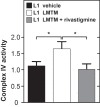Mechanisms of Anticholinesterase Interference with Tau Aggregation Inhibitor Activity in a Tau-Transgenic Mouse Model
- PMID: 32091331
- PMCID: PMC7403648
- DOI: 10.2174/1567205017666200224120926
Mechanisms of Anticholinesterase Interference with Tau Aggregation Inhibitor Activity in a Tau-Transgenic Mouse Model
Abstract
Background: Symptomatic treatments of Alzheimer's Disease (AD) with cholinesterase inhibitors and/or memantine are relatively ineffective and there is a need for new treatments targeting the underlying pathology of AD. In most of the failed disease-modifying trials, patients have been allowed to continue taking symptomatic treatments at stable doses, under the assumption that they do not impair efficacy. In recently completed Phase 3 trials testing the tau aggregation inhibitor leuco-methylthioninium bis (hydromethanesulfonate) (LMTM), we found significant differences in treatment response according to whether patients were taking LMTM either as monotherapy or as an add-on to symptomatic treatments.
Methods: We have examined the effect of either LMTM alone or chronic rivastigmine prior to LMTM treatment of tau transgenic mice expressing the short tau fragment that constitutes the tangle filaments of AD. We have measured acetylcholine levels, synaptosomal glutamate release, synaptic proteins, mitochondrial complex IV activity, tau pathology and Choline Acetyltransferase (ChAT) immunoreactivity.
Results: LMTM given alone increased hippocampal Acetylcholine (ACh) levels, glutamate release from synaptosomal preparations, synaptophysin levels in multiple brain regions and mitochondrial complex IV activity, reduced tau pathology, partially restored ChAT immunoreactivity in the basal forebrain and reversed deficits in spatial learning. Chronic pretreatment with rivastigmine was found to reduce or eliminate almost all these effects, apart from a reduction in tau aggregation pathology. LMTM effects on hippocampal ACh and synaptophysin levels were also reduced in wild-type mice.
Conclusion: The interference with the pharmacological activity of LMTM by a cholinesterase inhibitor can be reproduced in a tau transgenic mouse model and, to a lesser extent, in wild-type mice. Long-term pretreatment with a symptomatic drug alters a broad range of brain responses to LMTM across different transmitter systems and cellular compartments at multiple levels of brain function. There is, therefore, no single locus for the negative interaction. Rather, the chronic neuronal activation induced by reducing cholinesterase function produces compensatory homeostatic downregulation in multiple neuronal systems. This reduces a broad range of treatment responses to LMTM associated with a reduction in tau aggregation pathology. Since the interference is dictated by homeostatic responses to prior symptomatic treatment, it is likely that there would be similar interference with other drugs tested as add-on to the existing symptomatic treatment, regardless of the intended therapeutic target or mode of action. The present findings outline key results that now provide a working model to explain interference by symptomatic treatment.
Keywords: Alzheimer’s disease; Tau aggregation inhibitor; acetylcholinesterase inhibitor (AChEI); drug interaction; hydromethylthionine; mouse model; synaptic proteins; tauopathy..
Copyright© Bentham Science Publishers; For any queries, please email at epub@benthamscience.net.
Figures






References
Publication types
MeSH terms
Substances
LinkOut - more resources
Full Text Sources
Other Literature Sources
Medical
Miscellaneous

